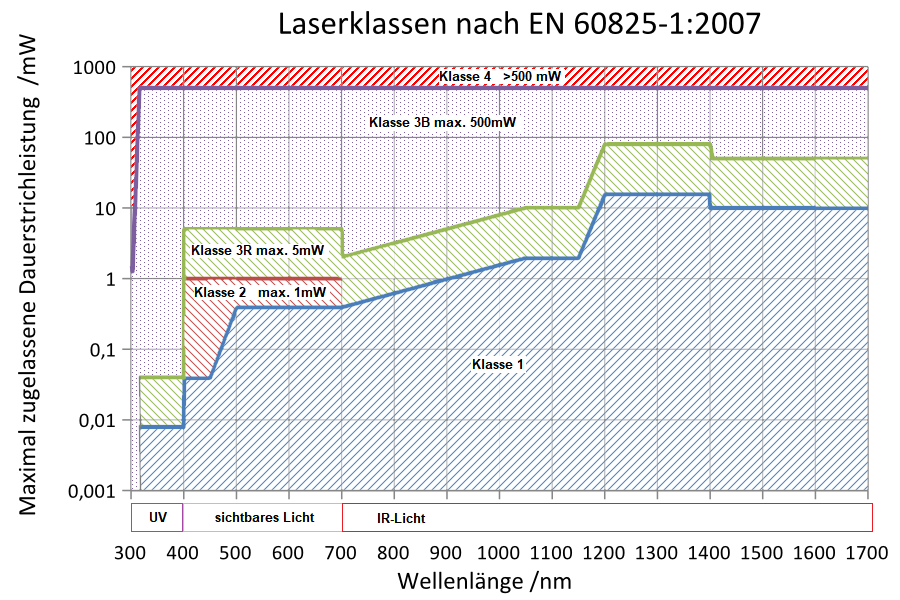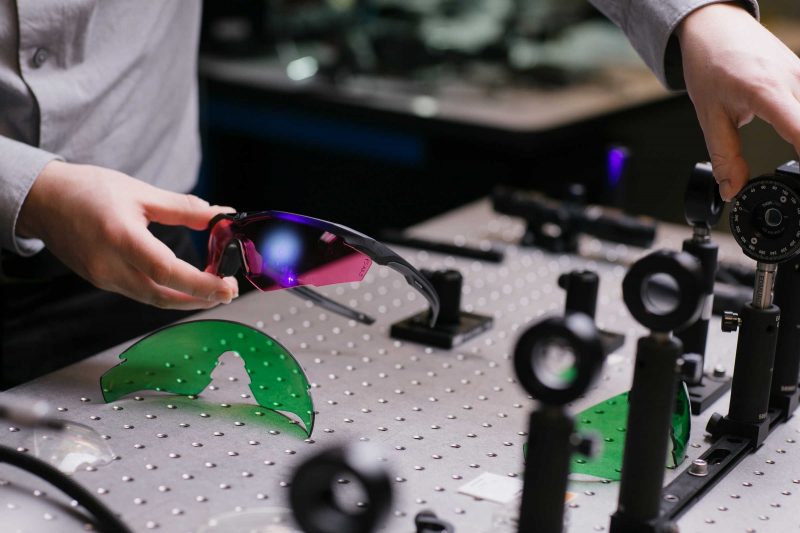Hol Dir den wöchentlichen SPARTANAT-Newsletter.
Dein Bonus: das gratis E-Book von SPARTANAT.

LASER: Die unsichtbare Gefahr
Die Blendung von Vollzugsbeamten mit einem Laser während Protesten wird immer beliebter. Dieser Trend ist in den USA und Europa bei verschiedenen "Demos" immer häufiger zu beobachten.
Bei Protesten wird es immer beliebter die Ordnungshüter mit einem Laser zu blenden. Dieser Tend lässt sich bei diversen sogenannten „Demos“ in den USA und auch in Europa immer öfter beobachten. Was im ersten Moment harmlos klingt, ist es nicht. Den die billigen aber extrem starken Laser aus Fernost können euch die Netzhaut wegbrennen. Also sollte man sich davor schützen, aber wie? Revison hat da einen Leitfaden für euch:
LASER-SPEZIFIKATIONEN
Es gibt drei wichtige Spezifikationen für Laserprodukte, die bei der Suche nach einem Augenschutz für Laser zu beachten sind. Das Leistungsniveau des Geräts (gemessen in Milliwatt), die Farbe des Lasers, die es ausstrahlt (ausgedrückt als seine Wellenlänge in Nanometern) und die Strahldivergenz (gemessen in Winkelminuten oder Milliradiant.) Wir werden Leistung und Farbe ausführlicher behandeln. Die Strahldivergenz gibt an, wie eng der Laserstrahl fokussiert ist. Breitere Strahlen stellen eine geringere Bedrohung dar.
LEISTUNG
Handlaser, die bei Straßenprotesten eingesetzt werden, reichen von meist harmlosen Schlüsselanhänger-Laserpointern mit niedriger Leistung bis hin zu hochintensiven Handlasern, die es mit der Leistung von Lasern aufnehmen können, die vom Militär zur Markierung meilenweit entfernter Ziele eingesetzt werden.
Woher wisst ihr, in welcher Gefahr ihr euch befindet, wenn ihr mit Lasern angestrahlt werdet? Unterm Strich wisst ihr es einfach nicht und die Demonstranten, die euch mit Lichtstrahlen beschießen, wissen wahrscheinlich nicht einmal, wie stark ihre Laser sind. Hier gehts zu unserem Artikel über Laserklassen.
Weil es teurer ist, einen weniger leistungsstarken Laser herzustellen, der die Sicherheitsnormen erfüllt, als einen leistungsstärkeren, der sie nicht erfüllt, ist es üblich, einen 3-mW-Laser über das Internet zu bestellen. Leider kann es sein, dass ihr einen zehnfach stärker als angegebenen Laser bekommt. Man kann also mit Sicherheit davon ausgehen, dass jeder Laser, der euch anstrahlt stark genug ist, um gefährlich zu sein.
 POTENZIELLE VERLETZUNG
POTENZIELLE VERLETZUNG
Die schlimmste Verletzung ist die irreversible Verbrennung der Netzhaut durch ein stark gebündeltes Licht. Die häufigere, aber ebenso schwerwiegende Gefahr, die von Lasern ausgeht, ist der Verlust des Situationsbewusstseins.
Ein Laser im Auge hat die gleiche Wirkung wie jede andere helle Lichtquelle. Er löst zunächst eine Schreckreaktion aus, die euch zum Blinzeln bringt. Wenn ihr weiter in den Laser schaut, werdet ihr geblendet und seht kaum mehr etwas. Wenn ihr dann noch länger in den Strahl schaut, erhaltet ihr vorübergehend helle Flecken, die sogenannten Nachbilder. Diese Effekte sind zwar nicht so schwerwiegend wie permanente Blindheit, aber das Situationsbewusstsein ist das Letzte, was ihr verlieren wollt, vor allem bei der potentiellen Gefahr von fliegenden Ziegelsteinen und selbstgemachter Pyrotechnik.
UNSICHTBARE GEFAHR
Die gute Nachricht: Ihr habt eine unfreiwillige Blinzelreaktion. Die schlechte Nachricht: Die Blinkreaktion tritt nur auf, wenn das beleidigende Licht im sichtbaren Spektrum liegt, und billige Laser sind oft mit unsichtbarem, IR- und Nah-IR-Licht verunreinigt.
Das bedeutet, dass ein schwacher, sichtbarer 5mW-Laser Hunderte von mW Licht im nahen IR-Spektrum herauspumpt. Wenn eure Augen ohne ersichtlichen Grund zu jucken und brennen beginnen, ist das ein Zeichen, dass das Licht die Netzhaut verbrennt.
 WIE STOPPT MAN EINEN LASER ?
WIE STOPPT MAN EINEN LASER ?
Auf der einfachsten Ebene ist die Farbe eines Lasers seine Achillesferse. Ihr wollt einen roten Laser stoppen? Stellt ihm einen rot-absorbierenden Filter in den Weg. Im Allgemeinen sehen Laserschutzlinsen entgegengesetzt zur Farbe aus, die sie absorbieren. Natürlich gibt es noch mehr, um einen Laser zu blockieren, aber eine wichtige Überlegung bei der Suche nach einem Laser-Augenschutz ist die Kenntnis der Farbe des Lichts, das ihr blockieren möchtet. Hersteller von Laser-Augenschutz geben diese Spezifikation als eine bestimmte Wellenlänge oder einen Wellenlängenbereich in Nanometern (nm) an.
FRAGE DER LINSENKONSTRUKTION
Eine Linse herzustellen, die einen Laser stoppt, bedeutet einen Farbstoff zu wählen der Licht mit der gleichen Wellenlänge wie der Laser absorbiert. Dies kann in Form einer Beschichtung geschehen, die nach der Herstellung einer Glas- oder Polymerlinse aufgetragen wird, oder durch Einmischen des Farbstoffs in das Basismaterial einer Polymerlinse, bevor diese in Form gebracht wird. Die letztere Methode der Konstruktion führt zu einer viel haltbareren Form des Laserschutzes, da der Farbstoff in die Linse imprägniert wird und nicht abgekratzt werden kann.
Die meisten Laserschutzlinsen werden für den Einsatz in einem Labor oder einer Fertigungsstraße hergestellt, wo es keineAnforderung an einen ballistischen Augenschutz gibt bzw. benötigt werden. Es gibt nur wenige Firmen, die einen Laser-Augenschutz herstellen, der auch einen ballistischen Schutz im Milchspektralbereich bietet.
 AUSWAHL DER RICHTIGEN LINSE
AUSWAHL DER RICHTIGEN LINSE
Es wäre toll eine Linse, die alle Laserwellenlängen blockiert zu haben, aber das gibt es nicht. Eine Linse, die alle Laserfarben blockieren würde, müsste alle Lichtfarben (Wellenlängen) herausfiltern. Das kann man machen, aber ihr seht dann auch nichts mehr. Da jede Linse nur in einer bestimmten Wellenlänge oder in einem bestimmten Wellenlängenbereich Laserschutz bieten kann, ist es bei der Auswahl einer Schutzlinse entscheidend, welche Farblaser euch erwarten werden.
Überlegt euch genau, zu welcher Tageszeit ihr den Laser-Augenschutz einsetzen werden. Die Nacht ist die richtige Zeit für Chaos, deshalb sollten die Linsen nicht zu dunkel sein. Die Angabe, die angibt, wie viel Licht eine Linse durchlässt, wird als Transmission des sichtbaren Lichts (VLT – visible light transmission) bezeichnet. Die VLT gibt an, wie viel (Tages-) Licht eine Linse prozentual durchlässt. Höhere Prozentsätze lassen mehr Licht durch.
Eine weitere wichtige Angabe ist die optische Dichte (OD – optical density) einer Linse. Die OD gibt an, wie viel Licht eines Lasers durch die Linse blockiert wird. Sie wird im Allgemeinen als Zahl von 0 bis 7 angegeben, wobei höhere Zahlen den größten Schutz bieten. Jede zusätzliche OD absorbiert zehnmal so viel Laserlicht, so dass eine Linse mit OD 3 zehnmal so viel Licht absorbiert wie eine Linse mit OD 2.
Praktisch gesprochen: Je höher die OD, desto mehr Laserenergie kann eine Linse absorbieren. Je höher die VLT, desto mehr Licht durchdringt die Linse.
VORSICHT VOR IR-ONLY-LINSEN
Bevor ihr mit der Schutzbrille, der euren IR-Ziellasern beilag, loszieht, solltet ihr euch vergewissern, dass diese Linsen auch im sichtbaren Lichtspektrum Schutz bieten. Dies IR-Schutzgläser eignen sich im Allgemeinen nur zum Stoppen von Lasern im IR/Near-IR-Spektrum und bieten nicht unbedingt Schutz vor sichtbaren Lasern.
AUSBLICK
Kurz gesagt, es ist schwierig sich zur Zeit vor Blendung aus allen Laserquellen zu schützen und zugleich noch das Situationsbewusstsein aufrecht zu halten. Einfach gesagt, noch etwas zu sehen, da alles rausgefiltert werden würde. Wer sich schützen will büst einen Teil seiner Sehwahrnehmung ein.
Die aktuelle Forschung und Entwicklung im Bereich des taktischen Augenschutzes gegen Laser konzentriert sich darauf, eine kompromisslose Lösung zu finden, die einen Laserschutz mit vollem Spektrum, ungehinderter Sicht und ballistischem Schutz auf Mil-Spec-Niveau bietet. Revision bietet euch schon jetzt eine große Auswahl an verscheidenen Laserschutzlinsen.
REVISION im Internet: www.revisionmilitary.com
SPARTANAT ist das Online-Magazin für Military News, Tactical Life, Gear & Reviews.
Schickt uns eure News: [email protected]
Werbung
Hol Dir den wöchentlichen SPARTANAT-Newsletter.
Dein Bonus: das gratis E-Book von SPARTANAT.


